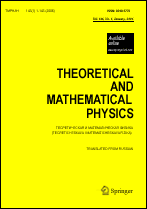|
This article is cited in 2 scientific papers (total in 2 papers)
Quantum duality in quantum deformations
V. D. Lyakhovsky
Saint-Petersburg State University
Abstract:
In accordance with the quantum duality principle, the twisted algebra $U_{\mathcal F}(\mathfrak g)$ is equivalent to the quantum group $\mathrm{Fun}_{\mathrm{def}}( \mathfrak G^{\#})$ and has two preferred bases: one inherited from the universal enveloping
algebra $U(\mathfrak g)$ and the other generated by coordinate functions of the dual
Lie group $\mathfrak G^{\#}$. We show how the transformation $\mathfrak g\longrightarrow\mathfrak g^{\#}$ can be explicitly obtained for any simple Lie algebra and a factorable chain $\mathcal F$ of extended Jordanian twists. In the algebra $\mathfrak g^{\#}$, we introduce a natural vector grading $\Gamma(\mathfrak g^{\#})$, compatible with the adjoint representation of the algebra. Passing to the dual-group coordinates allows essentially
simplifying the costructure of the deformed Hopf algebra $U_{\mathcal F}(\mathfrak g)$,
considered as a quantum group $\mathrm{Fun}_{\mathrm{def}}(\mathfrak G^{\#})$. The transformation $\mathfrak g\longrightarrow\mathfrak g^{\#}$ can be used to construct new solutions of the twist equations. We construct a parameterized family of extended Jordanian
deformations $U_{\mathcal{EJ}}\bigl(\mathfrak{sl}(3)\bigr)$ and study it in terms of $\mathcal{SL}(3)^{\#}$; we find new realizations of the parabolic twist.
Keywords:
Lie–Poisson structures, quantum deformations of symmetry, quantum duality.
Received: 30.10.2005
Revised: 24.11.2005
Citation:
V. D. Lyakhovsky, “Quantum duality in quantum deformations”, TMF, 148:1 (2006), 112–125; Theoret. and Math. Phys., 148:1 (2006), 968–979
Linking options:
https://www.mathnet.ru/eng/tmf2062https://doi.org/10.4213/tmf2062 https://www.mathnet.ru/eng/tmf/v148/i1/p112
|


| Statistics & downloads: |
| Abstract page: | 445 | | Full-text PDF : | 245 | | References: | 71 | | First page: | 1 |
|




 Contact us:
Contact us: Terms of Use
Terms of Use
 Registration to the website
Registration to the website Logotypes
Logotypes









 Citation in format
Citation in format 
